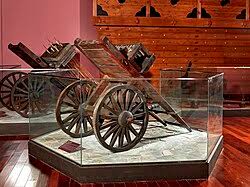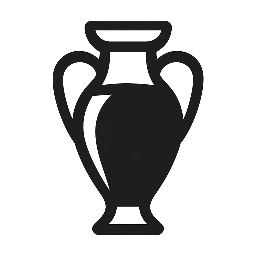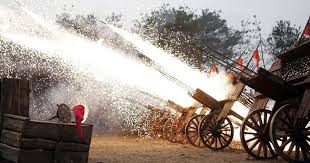Your basket is currently empty!
Introduction
The Hwacha (화차, literally “fire cart”) stands as one of the most terrifying and ingenious weapons ever devised by the Joseon Dynasty in 15th-century Korea. At a time when most military powers still relied on traditional bows, swords, and basic gunpowder weapons, Korea developed a multi-barreled rocket launcher capable of unleashing over 100 projectiles simultaneously. The Hwacha represented a quantum leap in military technology — combining the destructive power of gunpowder, the organization of volley fire, and the tactical advantage of mobility.
A Weapon Far Ahead of Its Time

Unlike earlier siege engines like catapults or ballistae, and unlike Chinese “fire arrows” that were largely single-use or limited in range, the Hwacha introduced a new paradigm: automated massed fire from a single device.
It was constructed on a sturdy two-wheeled wooden cart, making it relatively mobile for its time. Atop the cart sat a large wooden frame, drilled with a precise matrix of cylindrical launching slots, often numbering between 100 and 200. Into these were placed singijeon – gunpowder-propelled projectiles, either simple fire arrows or small rockets, depending on the variant.
When lit, the Hwacha could launch dozens or even hundreds of rockets in a single salvo, producing a terrifying visual and auditory display. Flaming arrows screaming through the air caused not only physical damage but also significant psychological disruption. Infantry formations would break rank, siege engines would burn, and cavalry would be forced to retreat under the blazing hail of fire.
Singijeon: The Power Behind the Hwacha
The real genius of the Hwacha was its ammunition. Singijeon (신기전), meaning “magical machine arrows,” were developed by Korean military scientists and craftsmen who experimented with gunpowder propulsion and aerodynamics.
There were three primary types of singijeon:
-
Small Fire Arrows – Designed for mass use; light, with short-range but great volume.
-
Medium Rockets – Capable of carrying small explosive charges.
-
Large Singijeon – Equipped with a timed fuse and explosive warhead, similar in concept to a modern rocket-propelled grenade (RPG).
These rockets could fly up to 200 meters, depending on wind and angle, and their explosive payloads could devastate groups of enemy soldiers or ignite siege equipment. Their aerodynamic design — including stabilizing fins — ensured more accurate trajectories than many other early rocket systems.
Importantly, the singijeon’s fuse was timed and measured using standardized templates, showing a level of precision rarely seen in pre-modern rocketry.
Strategic Context: Joseon Korea’s Defensive Needs
The development of the Hwacha was not just technological, but strategic. During the 15th century, Korea faced multiple threats:
-
Jurchen tribal raids from the north (modern-day Manchuria)
-
Internal revolts and banditry
-
The looming threat of Japanese piracy and later full-scale invasions
Under King Sejong the Great (r. 1418–1450), the Joseon government invested heavily in science and military reform. Scholars from the Hall of Worthies (Jiphyeonjeon) collaborated with military engineers to develop advanced weaponry — the Hwacha being one of their greatest accomplishments.
By the time of the Imjin War (1592–1598), when Japan invaded Korea under Toyotomi Hideyoshi, Hwacha units were deployed in key defensive positions — including fortresses like Jinju, naval ports like Busan, and even on warships.
While not as famous as Admiral Yi Sun-sin’s turtle ships, the Hwacha played a critical role in defending against massed infantry charges and siege warfare.
Tactical Use in Battle
The Hwacha’s use in actual combat was both defensive and offensive:
-
Defensively, it was placed on fortress walls or behind palisades, unleashing barrages to repel attacking troops.
-
Offensively, it supported field armies by breaking enemy ranks before close combat.
Unlike cannons, which had slower reload times and limited accuracy, Hwacha provided an immediate and wide-area attack, useful for:
-
Repelling multiple attackers in narrow passes
-
Defending chokepoints
-
Disabling siege towers before they reached walls
-
Creating chaos before a cavalry charge
Its only major drawback was reload time, which could take several minutes per volley. This was often mitigated by using multiple Hwacha units in staggered formation, so that one would fire while others reloaded.
Design Innovations and Korean Independence in Military Technology
While often superficially compared to Chinese rocket carts, the Hwacha was distinctly Korean in both design and application. Joseon engineers incorporated features absent in Chinese models:
-
Firing grids for mass launch coordination
-
Interchangeable racks to switch between singijeon sizes
-
Standardized ammunition production for easier logistics
-
Compact, mobile design for repositioning during battle
Korea in this period was not merely adopting Chinese tech — it was refining and outpacing it in several key areas of military science. The Hwacha is one of the clearest examples of Korean innovation and sovereignty in defense development.
Psychological Warfare and Battlefield Impact
Beyond its physical destruction, the Hwacha’s psychological effect was immense. The visual of hundreds of flaming arrows erupting from a single cart created panic, confusion, and disarray in enemy formations. Horses bolted, troops scattered, and siege operations were abandoned. The sound alone — a roaring whoosh followed by explosions — demoralized troops unfamiliar with gunpowder warfare.
Commanders who used Hwachas strategically could turn the tide of battle before swords were even drawn.
Legacy and Modern Recognition
Today, Hwacha replicas are proudly displayed in several Korean museums, including:
-
The War Memorial of Korea in Seoul
-
Jinju Fortress Museum
-
Gyeongbokgung Palace exhibitions
They also appear in:
-
Historical dramas such as Immortal Admiral Yi Sun-sin
-
Documentaries on East Asian military history
-
Korean school textbooks as symbols of innovation and patriotism
Beyond national pride, the Hwacha has gained international recognition as an early form of multiple rocket launcher — centuries before the modern Katyusha or Grad systems used in the 20th century.
Explore more historical war machines on our War Machines site.

